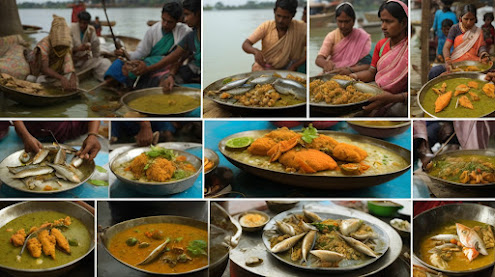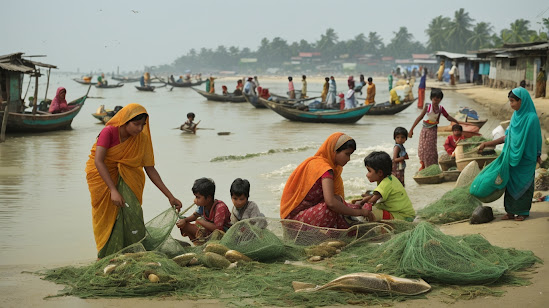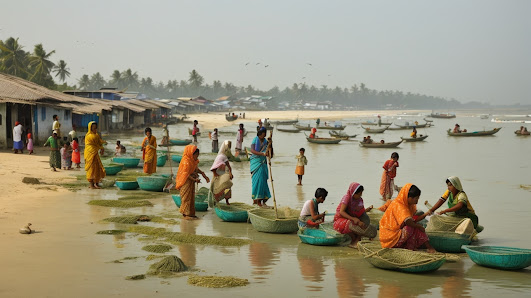Introduction:
Bangladesh,
a land of rivers and waterways, is a country deeply intertwined with the
aquatic world. Its geography, culture, and economy have been profoundly shaped
by the presence of abundant fish in its water bodies. In this article, we will
embark on a journey to explore the diverse and fascinating realm of fish in
Bangladesh.
Diving into the World of Fish in Bangladesh:
Nestled
in South Asia, Bangladesh is a nation defined by water. Its intricate network
of rivers, lakes, and wetlands cradles a diverse ecosystem that has long been a
source of life, culture, and sustenance for its people. At the heart of this
aquatic wonderland lies a captivating world of fish, each species with its own
unique story and significance. In this article, we embark on an underwater
journey to unveil the mesmerizing tapestry of fish in Bangladesh.
The Rivers That Shape a Nation
The lifeblood of Bangladesh, its rivers, are not mere waterways; they are vibrant ecosystems that host a plethora of fish species. The Ganges (Padma), Brahmaputra (Jamuna), and Meghna rivers, along with countless tributaries, create a mosaic of habitats that sustain an astonishing array of aquatic life.
Biodiversity Beneath the Surface
Bangladesh's
aquatic biodiversity is a treasure trove for biologists and nature enthusiasts.
From the iconic Hilsa, renowned for its delectable taste and cultural
significance, to the enigmatic Gourami, this nation boasts an impressive
variety of fish species, numbering in the hundreds. Each species plays a unique
role in the intricate web of life within its watery home.
Fishing: A Way of Life
For
generations, fishing has been a way of life for many communities in Bangladesh.
Traditional fishing techniques, handed down through the ages, have become an
integral part of the cultural fabric. Fishing is not merely an occupation; it's
a connection to the rhythms of nature and the pulse of the nation.
From Catch to Cuisine
The
journey of fish in Bangladesh doesn't end at the riverbanks. It continues to
sizzle and simmer in kitchens across the country. Bengali cuisine is renowned
for its exquisite fish dishes, from the spicy and tangy "Hilsa curry"
to the delicate flavors of "Rui Machher Kalia." Fish isn't just
sustenance here; it's a culinary art form.
Preserving the Piscatorial Heritage
As the demand for fish grows, so does the need for responsible fishing practices and conservation efforts. Bangladesh is acutely aware of the importance of protecting its aquatic resources. Initiatives to combat overfishing and habitat degradation are underway, ensuring that the fish that sustain the nation remain plentiful for generations to come.
Aquaculture: A Booming Industry
The
aquaculture industry in Bangladesh has seen remarkable growth, contributing
significantly to the country's economy. Shrimp farming, in particular, has
gained prominence on the global stage. This burgeoning industry has not only
created economic opportunities but also sparked conversations about
sustainability and environmental stewardship.
Challenges and Opportunities
Despite
its abundant aquatic resources, Bangladesh faces challenges such as pollution,
habitat destruction, and the impacts of climate change. These challenges are
not unique, as many nations grapple with similar issues. However, Bangladesh's
experiences and innovations in mitigating these challenges provide valuable
insights for the global community.
List of Main Fishes available in Bangladesh:
The
Hilsa (Tenualosa ilisha): The Jewel of Bengal
Arguably
the most revered fish in Bangladesh, the Hilsa, locally known as
"Ilish," holds a special place in the hearts and palates of Bengalis.
Its sleek, silvery body and delectable taste make it a culinary masterpiece.
Found in the country's rivers and estuaries, Hilsa is not just a fish; it's a
cultural icon.
Rui (Labeo rohita): The
Rohu
The
Rui, also known as Rohu, is a popular freshwater fish in Bangladesh.
Recognizable by its large, silver scales and a slightly protruding lower jaw,
the Rui is a staple in Bengali cuisine. It thrives in rivers, ponds, and lakes
throughout the country.
Katla (Catla catla): The
Silver Carp
The Katla, or Silver Carp, is another prized fish of Bangladesh. With its shiny scales and distinctive appearance, it is often considered the queen of freshwater fishes. Katla is widely used in traditional Bengali dishes, adding a unique flavor and texture to the cuisine.
Mrigel
(Cirrhinus cirrhosus): The Mrigal Carp
The
Mrigel, or Mrigal Carp, is a common fish found in Bangladesh's rivers and water
bodies. Recognized by its elongated body and distinctive barbels, this fish is
a significant source of protein for rural communities. It is often prepared in
curries and fried dishes.
Pangash (Pangasius
pangasius): The Pangas Catfish
Pangash,
or Pangas Catfish, is a prominent species in the aquaculture industry of
Bangladesh. Its fast growth rate and mild, white flesh have made it a popular
choice for commercial fish farming. Pangash has played a crucial role in
meeting the country's increasing demand for fish.
Tilapia (Oreochromis niloticus): The Tilapia
Tilapia,
a freshwater fish native to Africa, has found a comfortable home in Bangladeshi
waters. Its adaptable nature and mild taste have made it a favorite in both
aquaculture and cuisine. Tilapia fillets are often grilled, fried, or used in
various preparations.
Chitol (Chitala chitala): The Clown Knifefish
Chitol,
known for its distinctive, elongated body and striking appearance, is a prized
catch in Bangladesh. It is often featured in celebratory dishes and considered
a delicacy. Chitol is mainly found in large rivers and is highly valued for its
sweet and tender flesh.
Tengra
(Mystus tengara): The Mystus Catfish
Tengra,
or Mystus Catfish, is a smaller species commonly found in rivers and ponds
across Bangladesh. Recognizable by its slender body and prominent barbels, it
is frequently used in traditional Bengali fish curries and is known for its
delicate flavor.
Shing
(Heteropneustes fossilis): The Stinging Catfish
Shing, or Stinging Catfish, is a unique species characterized by its ability to produce venomous spines. While handling requires caution, the meat of the Shing is highly sought after for its distinct taste and is used in various Bengali dishes, particularly curries.
Pabda (Ompok pabda): The Butter Catfish
The
Pabda, or Butter Catfish, is a delightful freshwater fish known for its buttery
texture and mild flavor. It is often featured in special occasion dishes, where
its tender fillets shine in aromatic gravies and curries.
Boal
(Wallago attu): The Wallago Catfish
The
Boal, or Wallago Catfish, is a formidable predator of Bangladesh's rivers.
Recognizable by its large size and sharp teeth, it is both a challenging catch
and a delectable delicacy. Boal is often grilled or prepared in spicy curries.
Mola
Carplet (Amblypharyngodon mola): The Nutrient-Rich Gem
The
Mola Carplet, commonly known as Mola, is a small but nutritionally dense fish
found in the water bodies of Bangladesh. Despite its size, it packs a punch in
terms of essential nutrients, making it a valuable source of vitamins and
minerals, especially for rural communities.
Punti
(Puntius sophore): The Spotted Barb
Punti,
or Spotted Barb, is a petite fish distinguished by its silvery body adorned
with small dark spots. It thrives in ponds and rivers, contributing to the
aquatic biodiversity of Bangladesh. Although small in size, Punti has a
significant presence in the country's ecosystems.
Chanda
(Chanda nama): The Glassfish
Chanda, known as the Glassfish, is named for its translucent appearance. This small fish is often found in quiet waters, such as ponds and ditches. Its delicate beauty and subtle presence make it a charming addition to Bangladesh's aquatic fauna.
Puti
(Puntius conchonius): The Rosy Barb
Puti,
or Rosy Barb, is a tiny, colorful fish that graces the waters of Bangladesh.
With its vibrant hues and slender body, it is a favorite among aquarium
enthusiasts. In the wild, it adds a touch of color to the nation's waterways.
Shrimp
Goby (Glossogobius giuris): The Hidden Resident
The
Shrimp Goby is a small fish that forms a fascinating symbiotic relationship
with burrowing shrimp. These gobies share their burrows with shrimp, creating a
unique partnership where they warn each other of approaching predators. This
intriguing behavior highlights the complexity of Bangladesh's aquatic
ecosystems.
Yellowtail Catfish (Pangasius pangasius): The Mini Pangas
The
Yellowtail Catfish, often referred to as a mini Pangas, is a smaller relative
of the larger Pangas Catfish. It is a popular choice for aquaculture due to its
manageable size. Despite its diminutive stature, it contributes to the
country's fish production.
Ticto
Barb (Puntius ticto): The Ticto Barb
The
Ticto Barb, known simply as Ticto, is a small freshwater fish with distinct
black markings on its fins and tail. It adds diversity to the aquatic life of
Bangladesh's water bodies, where it thrives alongside other fish species.
Pomfret (Pampus spp.): The Silver Slab
Pomfret, with its distinctive flat, round body and silver skin, is a prized catch in Bangladesh. Its tender, white flesh is highly sought after and often featured in elegant seafood dishes. Pomfret is a staple in coastal cuisine, and its availability is a cause for celebration among seafood enthusiasts.
King
Mackerel (Scomberomorus spp.): The Speedy Predator
The
King Mackerel, also known as "Kingfish" or "Seerfish," is a
swift and powerful predator that inhabits the waters of Bangladesh. Its
elongated body and strong flavor make it a favorite for grilling and
pan-searing. This species is highly regarded for its taste and nutritional
value.
Prawn
(Penaeidae family): The Delicate Crustacean
Prawns,
or large shrimp, are abundant in the coastal waters of Bangladesh. These
crustaceans are prized for their sweet, delicate flavor and firm texture.
Prawns are featured in a variety of seafood dishes, from curries to grilled
preparations.
Red Snapper (Lutjanus spp.): The Scarlet Beauty
The
Red Snapper, adorned with its vibrant red scales and striking appearance, is a
sought-after catch in Bangladesh. Its firm, white flesh is well-suited for
grilling and baking. Red Snapper is a symbol of the rich seafood diversity
found in the Bay of Bengal.
Barramundi
(Lates calcarifer): The Asian Sea Bass
The
Barramundi, also known as Asian Sea Bass or Bhetki in Bengali, is a popular
fish in Bangladesh. Its mild, flaky flesh is versatile and used in various
culinary preparations, from fried fillets to delicate curries. Barramundi
aquaculture has gained prominence, contributing to the country's seafood industry.
Tuna
(Thunnini tribe): The Oceanic Nomad
Tuna,
a nomadic oceanic species, makes its presence felt in the waters of Bangladesh.
Its rich, meaty flesh is prized for its taste and nutritional value. Tuna is a
versatile fish, featured in sushi, sashimi, and canned products that reach
global markets.
Source of Bangladeshi Fish: An Exploration of Aquatic Abundance:
Nestled in the lush delta of South Asia, Bangladesh is a nation intricately woven with waterways. Its landscape, crisscrossed by a dense network of rivers, lakes, and wetlands, is not just a geographical feature but a source of life, culture, and sustenance. At the heart of this watery realm lies the essence of Bangladeshi fish—a vital resource that plays a profound role in the country's identity, cuisine, and economy. In this article, we embark on a journey to uncover the sources of Bangladeshi fish, delving deep into the aquatic wonders that define this nation.
The Mighty Rivers: Lifelines of Abundance
The
principal source of Bangladeshi fish can be traced to its mighty rivers, each
with its own unique character and contribution to the aquatic diversity. The
Ganges (known locally as the Padma), Brahmaputra (Jamuna), and Meghna rivers
form the backbone of the nation's aquatic ecosystems, serving as fertile
breeding grounds for an array of fish species.
Lakes
and Ponds: Hidden Treasures
Beyond
the rivers, Bangladesh boasts numerous oxbow lakes, floodplains, and man-made
ponds that are rich sources of fish. These smaller water bodies play a crucial
role in the country's fish production, often hosting indigenous and
economically important species that are integral to local diets and
livelihoods.
Wetlands and Haors: Biodiversity Havens
The
wetlands and haors (seasonal floodplains) of Bangladesh are pristine habitats
that provide sanctuary to countless fish species. These areas serve as crucial
breeding grounds, where fish thrive in the seasonal ebb and flow of water,
contributing significantly to the nation's fish stock.
Coastal Environments: A Marine Bounty
Bangladesh's coastline along the Bay of Bengal extends over 580 kilometers, offering a vast marine environment that is a source of diverse seafood, including fish. Coastal fishing communities rely on the bounties of the sea, contributing to the nation's seafood industry.
Traditional Fishing
Practices: Sustaining Livelihoods
While modern fishing methods have gained
popularity, traditional fishing practices remain deeply ingrained in
Bangladesh's cultural fabric. Indigenous methods such as cast netting, bamboo
traps, and artisanal fishing gear continue to be vital sources of fish,
supporting the livelihoods of countless rural communities.
Aquaculture
Revolution: Farming for the Future
In
recent decades, aquaculture has emerged as a significant source of Bangladeshi
fish production. Shrimp and fish farms have become integral to the nation's
economy, providing employment and meeting the growing demand for seafood both
domestically and abroad.
The
Culinary Heritage: Fish on the Plate
Fish
isn't just a commodity in Bangladesh; it's an essential part of the nation's
cuisine. From the iconic Hilsa to the humble Rui, fish dishes hold a special
place in Bengali kitchens. The source of Bangladeshi fish extends from
waterways to dinner plates, where it is transformed into a myriad of flavorful
dishes.
Challenges and
Sustainability: Balancing Act
As the demand for fish continues to grow, so do the challenges of overfishing, habitat degradation, and pollution. Bangladesh is actively working on sustainable fishing and aquaculture practices to ensure that the source of Bangladeshi fish remains abundant for future generations.
Bangladeshi Fishermen and Their Lifestyle:
Bangladesh,
often referred to as the "Land of Rivers," owes much of its identity
and prosperity to its extensive waterways. The lives of millions of
Bangladeshis are intricately intertwined with the ebb and flow of its rivers,
ponds, and the vast Bay of Bengal. Among these waters, it's the Bangladeshi
fishermen who stand as the guardians of a maritime heritage that has endured
for centuries. In this exploration, we delve into the unique lifestyle of
Bangladeshi fishermen, whose traditions and resilience continue to shape the
coastal culture and economy.
The
Coastal Communities: A Maritime Heritage
For
generations, coastal communities in Bangladesh have thrived on fishing. These
communities, with their distinctive cultures and livelihoods, have developed a
profound connection to the sea. Fishing is not just an occupation; it's a way
of life that has been passed down through the ages.
Fishing
Techniques: Tradition Meets Innovation
Bangladeshi
fishermen employ a wide range of fishing techniques, from traditional practices
like cast netting and bamboo traps to modern innovations like trawl nets and
motorized boats. These methods reflect a blend of age-old wisdom and adaptation
to contemporary needs.
Daily Life at Sea:
Hardships and Harmony
Life
at sea is challenging. Fishermen venture into the Bay of Bengal, facing the unpredictable
elements, long hours, and physical demands of their work. Yet, amidst these
hardships, there is a sense of harmony with nature as they navigate the rhythms
of the tides and the cycles of the moon.
Fishing
Festivals: Celebrating the Catch
Fishing festivals are an integral part of coastal life in Bangladesh. Events like the "Hilsa Festival" and "Pohela Boishakh" (Bengali New Year) are celebrated with fervor, marking the beginning of the Hilsa fishing season and the arrival of spring.
Community Bonds: The Strength of Solidarity
Coastal
communities are tightly knit, and the bonds among fishermen are strong. Mutual
support, cooperation during fishing expeditions, and sharing of knowledge and
resources are essential aspects of their way of life.
Cultural Riches: Music,
Dance, and Storytelling
The
rich maritime culture of Bangladeshi fishermen finds expression in music,
dance, and storytelling. Traditional songs like "Bhatiali" echo the
rhythms of the river, while dances and stories are passed down to the younger
generations, preserving their heritage.
Economic
Significance: A Lifeline for Many
Fishing
is not only a cultural tradition but also a significant contributor to the
national economy. It provides livelihoods for millions of people and is a vital
source of protein for the nation.
Challenges
and Sustainability: Navigating Troubled Waters
Despite
their resilience, Bangladeshi fishermen face challenges such as overfishing,
habitat degradation, and the impacts of climate change. These issues threaten
their way of life and the health of the coastal ecosystem.
Fishing as a Hobby of Bangladeshi People:
In Bangladesh, a nation known for its intricate network of rivers, lakes, and waterways, fishing isn't just a profession; it's a beloved hobby that has been woven into the cultural fabric for centuries. From the tranquil banks of rural ponds to the bustling riverbanks of Dhaka, fishing as a hobby has captured the hearts of countless Bangladeshi enthusiasts. In this exploration, we delve into the world of recreational fishing in Bangladesh, uncovering the serene pastime and deep-seated passion that it represents.
Angling
Tradition: From Necessity to Leisure
Fishing
has deep historical roots in Bangladesh, initially serving as a means of
sustenance for coastal and riverine communities. Over time, it evolved into a
leisurely pursuit, providing a respite from the rigors of daily life.
Peaceful Pursuit: Escaping the Hustle and
Bustle
For
many Bangladeshi anglers, fishing is a therapeutic escape from the chaos of
urban living. It offers a chance to unwind, connect with nature, and find
solace in the rhythmic ebb and flow of the water.
Fishing
Spots: From Urban Oases to Remote Retreats
Fishing
enthusiasts in Bangladesh are spoiled for choice when it comes to selecting
their angling destinations. Urban parks, serene ponds, meandering rivers, and
remote lakes all offer unique fishing experiences.
Variety
of Catch: From Local Delicacies to Trophy Fish
Bangladeshi
anglers pursue a diverse range of fish species, from the common tilapia and
catfish to more prized catches like the hilsa. Each catch brings its own thrill
and satisfaction.
Catching Techniques:
Balancing Skill and Patience
Anglers
employ a variety of techniques, including bait fishing, fly fishing, and spin
casting, honing their skills through practice and patience.
Fishing
Seasons: Timing Matters
Fishing
enthusiasts in Bangladesh are keenly attuned to the seasons, as different times
of the year yield different catches. The monsoon season, for example, heralds
the arrival of the prized hilsa.
Community and
Camaraderie: Bonding Over Fishing
Fishing
is often a communal activity in Bangladesh, where friends and family gather by
the water to share stories, laughter, and, of course, the day's catch.
Conservation
and Responsibility: Preserving the Waters
Bangladeshi anglers are increasingly conscious of the need for responsible fishing and conservation efforts to ensure the sustainability of their beloved pastime.
A Time-Honored Passion
Fishing
as a hobby in Bangladesh is more than just catching fish; it's about forging
connections with nature, savoring moments of tranquility, and carrying forward
a tradition that has been cherished for generations. Whether casting lines in
urban ponds or embarking on remote angling adventures, Bangladeshi anglers find
solace, joy, and a profound connection to their country's aquatic heritage
through their beloved hobby.
Fisheries and Earned Revenue of Bangladesh:
The
Aquatic Wealth of Bangladesh
In
Bangladesh, where waterways weave an intricate tapestry across the landscape,
fisheries play a pivotal role in the nation's economy. The country's rivers,
ponds, and coastal areas teem with a diverse array of fish species, making
fisheries a significant contributor to its earned revenue. In this
comprehensive exploration, we delve into the world of fisheries in Bangladesh,
dissecting the mechanisms, challenges, and economic impact of this vital
sector.
The Fisheries Industry: A
Pillar of Bangladesh's Economy
Fisheries
are a cornerstone of the Bangladeshi economy, providing employment,
nourishment, and substantial revenue. This industry has grown exponentially
over the years, thanks to both traditional practices and modern aquaculture
techniques.
The Role of Inland Fisheries: A
Bountiful Harvest
Inland
fisheries, characterized by the farming of various freshwater fish species in
ponds, lakes, and rivers, constitute a significant portion of Bangladesh's fish
production. Traditional fish farming practices coexist with advanced
aquaculture methods, ensuring a consistent supply of fish to local and
international markets.
Coastal Fisheries: Navigating the Bay of Bengal
Bangladesh's extensive coastline along the Bay of Bengal is a rich source of marine resources. Coastal fishing communities rely on a variety of techniques, from artisanal methods to mechanized trawling, to harvest the bounty of the sea. This sector contributes not only to domestic consumption but also to seafood exports, earning valuable foreign exchange.
The
Economic Impact: A Boon for the Nation
The
fisheries sector is a major contributor to Bangladesh's earned revenue. It not
only provides livelihoods for millions of people but also generates substantial
income through exports. The revenue generated from fish and seafood exports
bolsters the nation's economic stability and growth.
Challenges and Sustainability:
Navigating Troubled Waters
The
fisheries sector faces numerous challenges, including overfishing, habitat
degradation, and the impacts of climate change. Sustainable practices and
conservation efforts are essential to ensuring the long-term viability of this
crucial industry.
Government Initiatives: Promoting Growth and Sustainability
The
Bangladeshi government recognizes the significance of the fisheries sector and
has implemented various policies and programs to promote sustainable fishing
practices, enhance infrastructure, and support small-scale fishermen.
International
Trade: Exporting Bangladeshi Seafood
Bangladeshi
seafood, including shrimp, prawns, and various fish species, enjoys a strong
presence in international markets. Exports of seafood products contribute
significantly to the country's earned revenue.
Sustaining the Fisheries Legacy
The fisheries sector of Bangladesh stands as a testament to the nation's enduring relationship with its aquatic resources. As it continues to navigate the challenges and opportunities presented by its water-rich landscape, the sector remains a key driver of earned revenue, employment, and nutritional security. The sustainable management of fisheries is not only a path to economic growth but also a commitment to preserving the aquatic wealth that has sustained Bangladesh for generations.
Conclusion
As
we conclude our exploration of fish in Bangladesh, we are left with a profound
appreciation for the integral role these aquatic creatures play in the nation's
culture, economy, and environment. Bangladesh's waters hold not just fish but a
rich tapestry of stories and connections that bind its people to their aquatic
heritage. The journey through this world of fish has been a reminder of the
delicate balance between exploitation and conservation, a lesson that
transcends borders and resonates with all who appreciate the wonders of our
natural world.























0 Comments